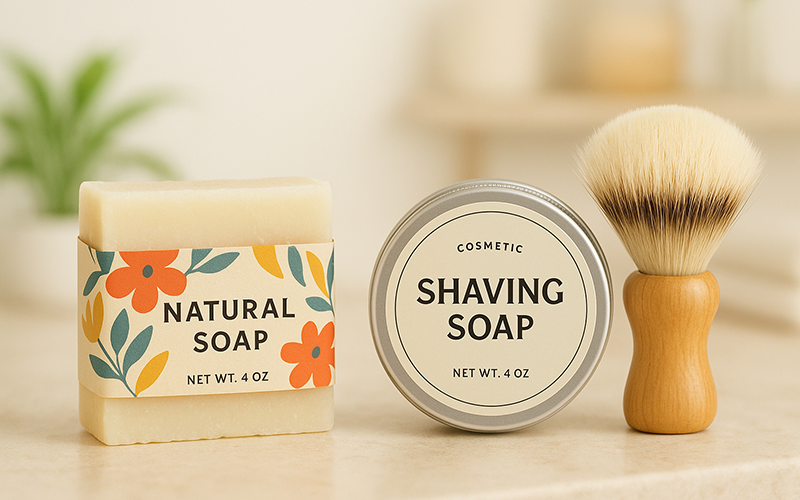Soap can be a surprisingly tricky product when it comes to labeling and regulation. It’s sort of a chameleon. How it’s regulated depends on several different factors; the same soap can be a soap, a cosmetic, a pesticide, or a drug–just depending on how it’s made and what you say about it!
Since soap is applied to the human body to cleanse, it defaults to being a cosmetic. Except there is a regulatory exemption, so some soap is exempt from the definition of a cosmetic. I call it “non-cosmetic soap,” but it’s also sometimes referred to as “true soap.”
The distinction is important because it determines which rules apply, which agency has authority, how you can label and market your products, and what you can use to make them.
Let’s walk through the similarities and differences so you can decide which path makes the most sense for your soap business.
What Makes Soap “Exempt”?
The key reference is in the regulations (21 CFR 701.20, if you want to look it up), which defines what qualifies as soap that is not a cosmetic. To be exempt:
- The bulk of the nonvolatile matter must consist of the alkali salt of fatty acids (what we know as “soap” made by combining oils/fats with lye). [Non-volatile matter is what’s left after the water or alcohol (volatile material) evaporates away.}
- The product must be labeled and marketed only as “soap.”
- No cosmetic claims can be made (such as moisturizing, exfoliating, or deodorizing).
If your soap product doesn’t meet these criteria, then it’s regulated as a cosmetic.
A bar that is lye/oil soap is a cosmetic when it is called something else (shampoo bar, for example) or used for a reason other than cleansing (a shaving soap that is used for slip, not cleansing).
Something that is applied to the human body and called soap, but doesn’t meet that definition, is a cosmetic. That would include items such as soft soap, moisturizing bars, and detergent-based melt-and-pour soap.
Who Regulates What
- Non-cosmetic soap falls under the Federal Trade Commission (FTC), which enforces the Fair Packaging and Labeling Act (FPLA) for packaging consumer commodities and the Consumer Product Safety Commission for product safety.
- Soap that is a cosmetic is regulated by the Food and Drug Administration (FDA) under the Food, Drug, and Cosmetic Act (FDCA).
- MoCRA (Modernization of Cosmetics Regulation Act of 2022) applies only to cosmetics, so it affects cosmetic soap but not non-cosmetic soap.
Labeling Requirements
Both types of soap must comply with the basic labeling rules:
- Statement of identity (what the product is)
- Net quantity of contents
- Name and address of the responsible party
The difference on the label lies in the ingredient declaration:
- Cosmetic soap must follow FDA rules for ingredient listing, including correct ingredient names, order of ingredients, font size, and formatting.
- Exempt soap doesn’t require an ingredient declaration. However, if you choose to provide one, it must still be truthful and not misleading. You have more flexibility, such as listing “olive oil” instead of Olea europaea.
Color Additives
This is a big difference:
- Cosmetic soap: can only use FDA-approved color additives, and they must be declared properly.
- Exempt soap: the FDA’s cosmetic color additive rules don’t apply, so you can use natural clays, herbs, or other traditional colorants that may not be on FDA’s approved list.
Pros & Cons of Non-Cosmetic Soap
PROS:
- Less regulation: No FDA registration, MoCRA compliance, or cosmetic GMP requirements.
- Simpler labeling: No ingredient declaration required.
- More flexibility with colorants: You can use natural botanicals without worrying about FDA approval.
CONS:
- No cosmetic claims: You can’t market your soap as moisturizing, nourishing, deodorizing, or skin-conditioning. You’re limited to saying it “cleans.”
- Marketing limits: Many consumers look for added benefits, and you can’t highlight them if you want to stay exempt.
Side-by-Side Comparison
| Feature | Soap Exempt from Cosmetics | Soap That is a Cosmetic |
|---|---|---|
| Regulating Agency | FTC for labeling CPSC for safety | FDA for labeling and safety. |
| Law | Fair Packaging & Labeling Act | Food, Drug & Cosmetic Act |
| MoCRA Applies? | No | Yes |
| Reporting of Adverse Event | Must report to CPSC | Must report to FDA |
| Basic Labeling | Required | Required |
| Ingredient Declaration | Not required (optional, must be truthful) | Required, must meet regulations in requirements for formatting, order, and ingredient names. |
| Color Additives | No restrictions (must be safe) | Must use FDA-approved color additives |
| Claims Allowed | Only “soap” and cleansing | Cosmetic claims (moisturizing, deodorizing, etc.) |
| Regulatory Burden | Lower | Higher |
Final Thoughts
Both paths are valid—it just depends on how you want to market your soap. If you want to keep things simple and focus on traditional soapmaking, staying exempt may be the best fit for you. If you want to make cosmetic claims and tout your soap’s great (cosmetic) benefits, then cosmetic soap (and FDA compliance) is the way to go.
Either way, knowing where your product stands will help you make clear, compliant decisions about your labels and your business.


Leave a Reply